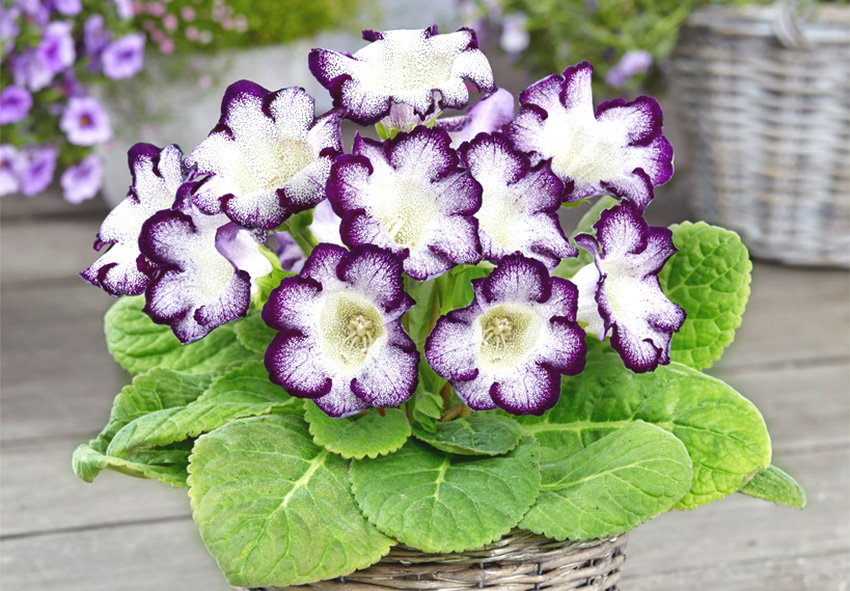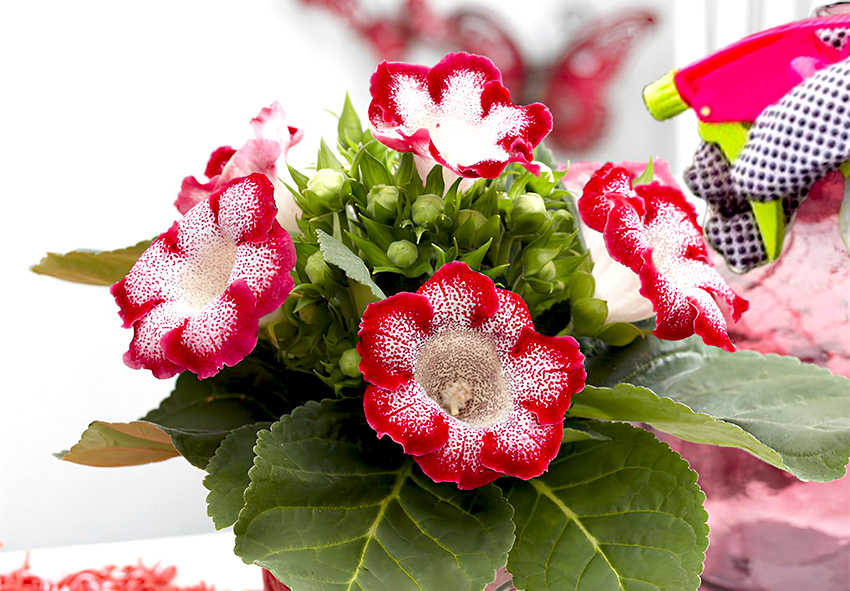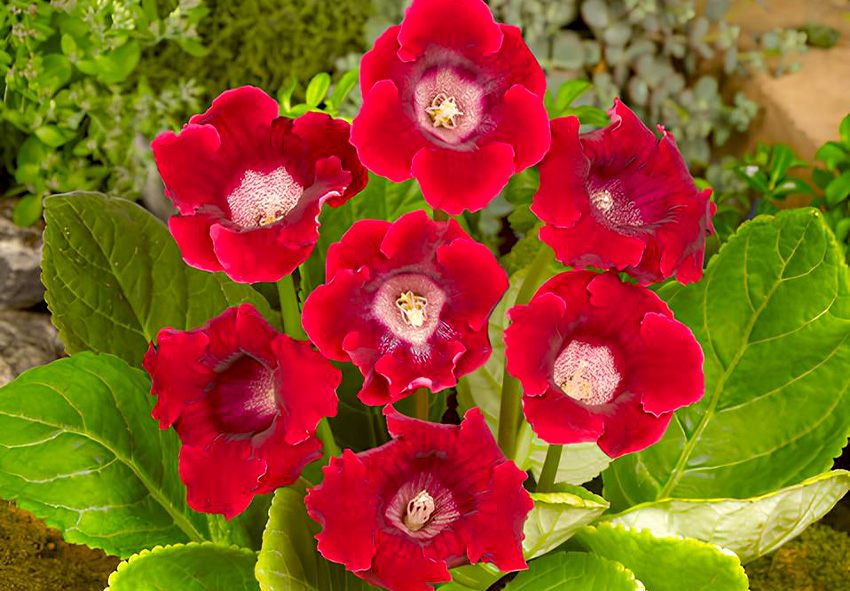Gloxinia, particularly the beloved Sinningia speciosa, is a tropical flowering plant prized for its lush, velvety blooms and compact foliage. Perfect for bright indoor spaces, Gloxinia makes a stunning houseplant that rewards care with vibrant colors and dramatic flowers. In this full guide, we’ll explore everything you need to know—from growing Gloxinia indoors to managing its seasonal dormancy. Our gardening blog is a perfect place to find all the information you need!
Understanding Gloxinia Plants

Before you dive into caring for Gloxinia, it helps to understand the plant’s background and defining features. From its tropical origins to its striking flowers, Gloxinia brings both beauty and botanical interest into your home.
Botanical Background
Gloxinia belongs to the Gesneriaceae family and is native to South America. The most common species, Sinningia speciosa, has been cultivated for centuries for ornamental use. While once classified in the genus Gloxinia, it is now more accurately known as Sinningia, though “Gloxinia” remains a popular name.
Key Characteristics
Gloxinia (Sinningia speciosa) is a beloved flowering plant known for its rich blooms and lush foliage. These key traits make it a standout addition to any indoor garden:
- Vibrant, Bell-Shaped Flowers – Gloxinia is prized for its velvety, trumpet-like blooms in a variety of vivid colors, including purple, red, pink, and white.
- Lush, Velvety Leaves – The plant features large, soft green leaves with a velvety texture, adding a rich backdrop to its colorful flowers.
- Compact Growth Habit – Gloxinia typically grows in a compact, bushy form, making it ideal for containers and small indoor spaces.
- Seasonal Bloomer – Most Gloxinia varieties bloom in late spring to summer, followed by a dormancy period in fall and winter.
- Tuberous Root System – Gloxinia grows from tubers, which can be stored and regrown seasonally, making it a great plant for long-term cultivation.
How to Grow Gloxinia Indoors
Growing Gloxinia indoors is ideal for showcasing its vibrant blooms and lush foliage. With the right lighting, temperature, and potting setup, your Gloxinia can thrive on windowsills or tabletops throughout the year.
Light and Temperature Requirements
Gloxinia thrives in bright, indirect light—such as near an east-facing window. Direct sunlight can scorch the leaves, so filtered light is best. The plant prefers temperatures between 65–75°F (18–24°C) and should be protected from drafts and sudden temperature drops.
Potting Mix and Container Tips
Use a light, well-draining potting mix, ideally one formulated for African violets or tropical plants. A container with drainage holes is essential to prevent root rot. Repot Gloxinia after dormancy or when the tuber outgrows the current pot.
Watering and Feeding Gloxinia

Proper hydration and nutrition are essential for keeping Gloxinia healthy and blooming. Learn the best practices for watering and fertilizing your plant without risking rot or nutrient imbalance.
Proper Watering Schedule
Maintaining a consistent watering routine is essential for healthy Gloxinia growth and vibrant blooms. Follow this schedule to avoid overwatering or dehydration:
- During Active Growth (Spring to Early Summer): Water thoroughly when the top inch of soil feels dry. Ensure even moisture, but avoid letting the soil become soggy, which can cause root rot.
- While Flowering: Increase watering slightly as the plant uses more water during blooming. Always water at the base, avoiding leaves and flowers to prevent fungal issues.
- After Flowering (Pre-Dormancy): Gradually reduce watering as the flowers fade and the plant prepares for dormancy. Let the soil dry more between waterings.
- Dormant Period (Late Fall to Winter): Water sparingly—just enough to prevent the tuber from completely drying out. Overwatering during dormancy can lead to rot.
- Humidity Consideration: Maintain moderate humidity around the plant with a pebble tray or humidifier, especially during dry indoor heating seasons.
Fertilization Needs
Feed your Gloxinia every two weeks during the active growing season with a balanced, water-soluble fertilizer. A fertilizer high in phosphorus can help promote more blooms. Stop fertilizing once the plant enters its dormant phase.
Gloxinia Flowering and Dormancy
Gloxinia goes through a natural cycle of active blooming and dormancy. Understanding how to support your plant during each phase will lead to healthier growth and more frequent, spectacular flowers.
Encouraging Blooms
To encourage flowering, provide the right balance of light, warmth, and nutrients. Deadheading spent blooms can stimulate new flower production. Avoid stressing the plant, as inconsistency in care can reduce flowering.
Dormant Period Care
After blooming, Gloxinia naturally enters dormancy, during which the foliage dies back. Reduce watering, stop fertilizing, and store the tuber in a cool, dark place. Resume care in late winter or early spring when new growth appears.
Propagating Gloxinia

If you want more Gloxinia plants or wish to rejuvenate an aging one, propagation is a great option. Discover the techniques for growing new plants from tubers or leaf cuttings.
Growing from Tuber or Bulb
To propagate from a tuber, plant it shallowly in moist potting mix with the eye facing up. Keep it warm and slightly humid until shoots emerge. This method is ideal for renewing older plants or sharing with fellow gardeners.
Leaf Cuttings and Other Methods
Gloxinia can also be propagated from leaf cuttings by placing a healthy leaf in moist soil or water until roots form. While slower than tuber propagation, this method is rewarding and economical.
Common Problems and Solutions
Even with good care, Gloxinia can encounter issues like pests, diseases, or stunted growth. Here’s how to identify and address the most common problems to keep your plant thriving.
Pests and Diseases
Proper monitoring and care can prevent most issues, but it’s important to recognize the signs early to keep your Gloxinia healthy:
- Aphids – These small, soft-bodied insects cluster on new growth and buds, sucking sap and causing distortion. Control with insecticidal soap or neem oil.
- Spider Mites – Tiny mites that create fine webbing and cause stippled, yellowing leaves. Improve humidity and use miticides if necessary.
- Mealybugs – White, cotton-like pests that hide in leaf axils and under leaves. Remove manually or treat with alcohol-dipped swabs.
- Botrytis (Gray Mold) – A fungal disease that causes fuzzy gray mold on leaves and flowers, especially in humid conditions. Improve air circulation and remove affected parts.
- Root Rot – Often caused by overwatering or poor drainage. Prevent by using well-draining soil and letting the top inch of soil dry before watering.
Troubleshooting Growth Issues
Yellowing leaves may indicate overwatering or low light, while stunted growth can result from insufficient nutrients. Ensure your plant has the right conditions—consistent temperature, moisture, and feeding—to thrive.
Outdoor Growing and Seasonal Tips

Although Gloxinia is typically grown indoors, it can enjoy time outside during the warmer months. Follow these seasonal tips to transition your plant safely and boost its performance year-round.
When to Move Gloxinia Outdoors
Gloxinia can be moved outside in summer when temperatures stay above 60°F (15°C). Choose a shaded patio or covered area to protect from direct sunlight and rain. Always bring the plant indoors before the first frost.
Seasonal Maintenance
Maintaining Gloxinia through the seasons ensures consistent blooming and long-term plant health. Here’s how to care for your plant year-round:
- Spring: Resume watering and fertilizing as new growth appears. Repot if needed, and place in bright, indirect light to stimulate budding.
- Summer: Keep the soil evenly moist, avoid water on leaves, and feed with a balanced fertilizer every 2–3 weeks. Deadhead spent flowers to encourage continued blooming.
- Fall: Reduce watering gradually as the plant slows down. Stop fertilizing and allow foliage to naturally yellow and die back.
- Winter: Let the plant rest in a cool, dry location. Keep the soil just barely moist and avoid disturbing dormant tubers until new growth resumes.
Conclusion
With its vivid blossoms and compact size, Gloxinia is a striking addition to any indoor garden. By understanding its light, water, and dormancy needs, you can enjoy beautiful blooms year after year. Browse our online store today to find premium Gloxinia tubers and get started on growing this classic, eye-catching plant at home.
Frequently Asked Questions (FAQs) about Gloxinia
1. How often should I water my Gloxinia plant?
Water Gloxinia when the top inch of soil feels dry. During the growing and flowering season, this typically means watering once or twice a week. Reduce watering as the plant enters dormancy. Avoid getting water on the leaves to prevent rot and fungal issues.
2. Why are my Gloxinia’s leaves turning yellow?
Yellowing leaves in Gloxinia can be due to overwatering, poor drainage, or insufficient light. Ensure the plant receives bright, indirect sunlight and water only when the soil is slightly dry. Also, check for signs of pests or diseases that might stress the plant.
3. Can Gloxinia grow outdoors year-round?
Gloxinia can be grown outdoors only in warm climates (USDA zones 10–11) where frost isn’t a concern. In cooler regions, treat Gloxinia as an indoor or seasonal plant and bring it indoors before temperatures drop below 60°F (15°C).
4. Can Gloxinia bulbs be ordered from your online store?
Yes, you can! Our online store Dutch-bulbs.com offers a wide selection of Gloxinia plants, including different varieties and colors. We provide top-quality plants that are carefully cultivated and shipped with care to ensure they reach you in perfect condition.
5. How do I get my Gloxinia to bloom again?
After the flowering period, allow your Gloxinia to rest by reducing watering. During dormancy, keep the tuber in a cool, dry place. Resume watering and feeding in early spring. With the right conditions, new growth will emerge, and flowering will follow.
Published: 30.05.2025
